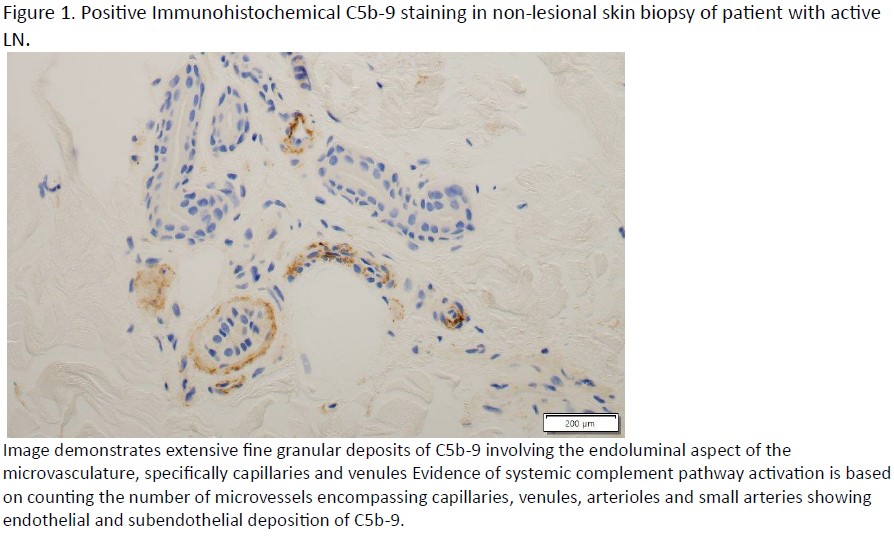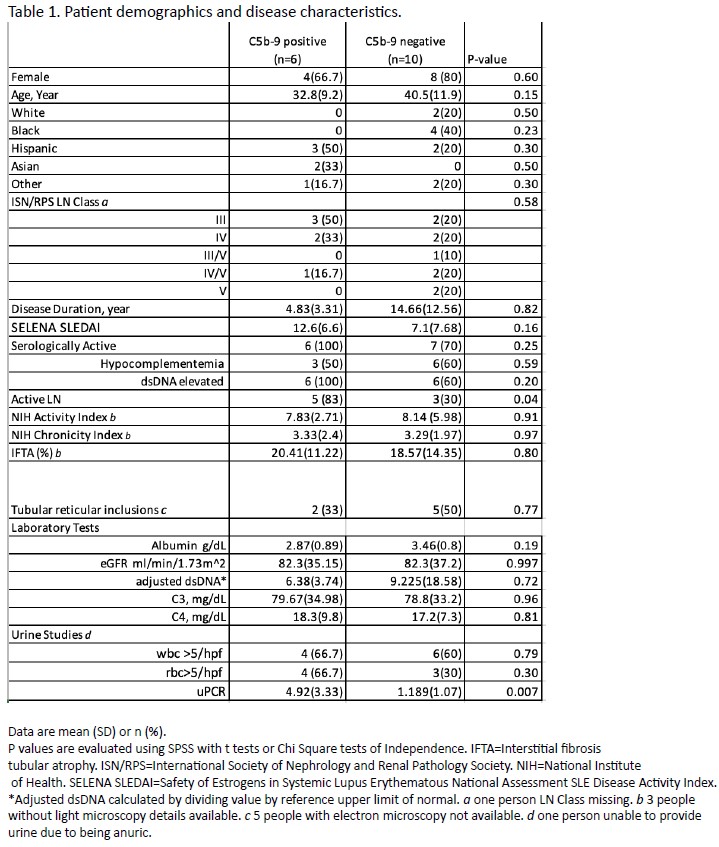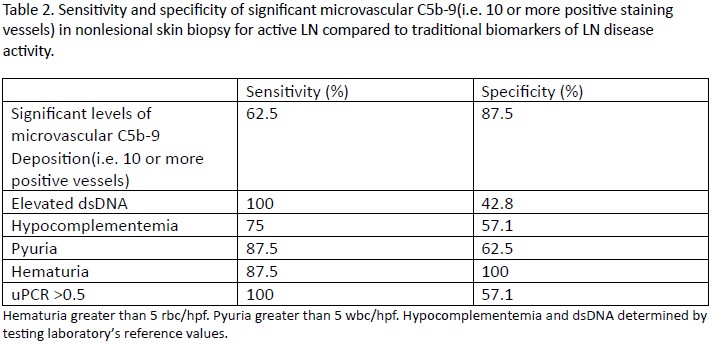Session Information
Date: Sunday, November 12, 2023
Title: (0543–0581) SLE – Diagnosis, Manifestations, & Outcomes Poster I
Session Type: Poster Session A
Session Time: 9:00AM-11:00AM
Background/Purpose: Tissue damage in LN is mediated by immune complex activation of the classic complement pathway (PMID 23929771). In a study of LN, renal C5b-9 deposition was more frequent in nonresponders (45.5%) than responders (13%) (PMID 34996855). Additionally, complement mediated upregulation of endothelial cell adhesion molecules is seen in the dermal blood vessels of nonlesional skin (NLS) from patients with active SLE (PMID 9336415). In diseases with systemic complement activation (SCA), such as atypical hemolytic uremic syndrome, extensive C5b-9 deposition is seen in NLS (PMID 25893747). This supports hypothesis that NLS C5b-9 deposition is a biomarker for disease activity and evidence of SCA in LN
Methods: Sixteen LN patients without TMHA consented to 4 mm NLS deltoid biopsies, were ≥18 years of age, met ACR SLE classification criteria, and a history of biopsy proven LN or undergoing first clinically indicated renal biopsy. In those undergoing renal biopsy, skin biopsy was performed within 7 days. Formalin fixed paraffin imbedded skin samples were stained for C5b-9 via diaminobenzidine technique and reviewed by dermatopathologist experienced in assessing microvascular C5b-9(PMID 33058948); she was blinded to clinical history. Classification as active LN required an activity index (AI) of ≥1 on biopsy or urine protein creatinine ratio (uPCR) > 0.7 and albumin < 3.7 g/dL. Inactive LN required AI of 0 or a uPCR ≤0.7, albumin ≥3.7 g/dL and no escalation of care by treating physician. Clinical, demographic, and lab parameters were compared between individuals based on presence of evidence of SCA as determined by demonstrating ≥ 10 blood vessels with endothelial or subendothelial C5b-9 deposition in NLS(PMID 33058948)
Results: Sixteen patients included: 12 females, mean age 37 years, 4 Black, 2 White, 2 Asian, 5 Hispanic and 3 other with clinical characteristics in Table 1. Of the 16 patients, 8 had active LN and 6(37.5%) were positive for endothelial C5b-9 deposition (Figure 1). Of those with SCA compatible C5b-9 deposition, 5 of 6 (83%) had active LN. Of those without significant C5b-9 deposition, 3 of 10 had active LN. Five of 8 active LN patients and 1 of 8 inactive LN patients demonstrated SCA compatible C5b-9 (p= 0.04). These findings demonstrate that SCA is present in LN and is significantly more common in active disease. Cutaneous evidence of SCA as demonstrated by quantitative C5b-9 assessment in microvessels has greater specificity, 87.5%, for active LN than pyuria, low complements, elevated dsDNA, and proteinuria (Table 2). uPCR was significantly higher in LN patients with C5b-9 deposition (4.92 vs 1.19; p =0.007). C5b-9 deposition was not associated with a higher AI, interstitial fibrosis, dsDNA, or lower complements (Table 2)
Conclusion: This is the first study to demonstrate evidence in NLS of levels of microvascular C5b-9 indicative of SCA in LN. C5b-9 deposition indicative of SCA is statistically more common and demonstrated greater specificity than historical biomarkers in active LN. Findings support a potential role for microvascular C5b-9 assessment in NLS as biomarker for LN activity. Long term follow up needed to assess if NLS evidence of SCA associates with less treatment response or poor outcomes in active LN
To cite this abstract in AMA style:
Anderson M, Magro C, Belmont H. Prospective Observational Study of Microvascular C5b-9 Deposition in Non-lesional Skin in Systemic Lupus Erythematosus Patients and Its Correlation with Active Lupus Nephritis [abstract]. Arthritis Rheumatol. 2023; 75 (suppl 9). https://acrabstracts.org/abstract/prospective-observational-study-of-microvascular-c5b-9-deposition-in-non-lesional-skin-in-systemic-lupus-erythematosus-patients-and-its-correlation-with-active-lupus-nephritis/. Accessed .« Back to ACR Convergence 2023
ACR Meeting Abstracts - https://acrabstracts.org/abstract/prospective-observational-study-of-microvascular-c5b-9-deposition-in-non-lesional-skin-in-systemic-lupus-erythematosus-patients-and-its-correlation-with-active-lupus-nephritis/



